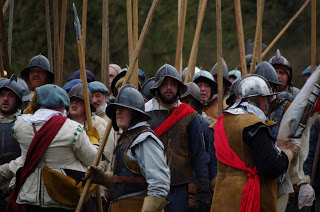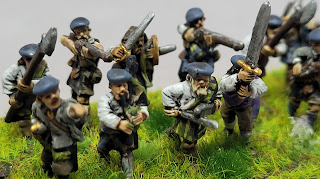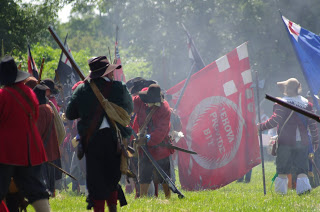Standards
My Napoleonic armies date from a time when standard bearers had metal flags cast as part of the figure. Which to be very honest was a complete pain to paint. There are ways round this, but still a pain to a cack handed painter like myself.
Thankfully not an issue with my figures: oh joy of joys I can use commercially available flags!
Update: if you would like a crash course in understanding Civil War flags try this article written by one of the re-enactors from Newcastle's white-coats. Or you could try my own three part series on flags and colours which starts here with part one.
Of course if you are a talented artist you could always create your own, there are a number of books which list known flags, a number of rule books have flag sections e.g. Forlorn Hope, or there are the old Military Modelling articles hosted by the BCW Wiki (direct download link). Please note that there are errors in these old Military Modelling articles which have been replicated ad infinitum since they were first published - if only the authors had read the source document notes rather than just looked at the pictures!
But which commercial flags to choose? For ECW 15mm two of the largest sources in the UK are Wargames Designs or Maverick Models. I fancied something a bit special so went for the Maverick material flags rather than paper ones. Coincidentally Maverick are based in Macclesfield, which considering where this whole adventure began, lends some Eastern mysticism to the occasion.
Two standards from my latest batch drying after being 'painted' with a 50/50 PVA water mix. (I always put them on plastic to dry, then put them on the radiator to dry thoroughly. Don't worry if they curl slightly, this first step is just to stop them fraying when you cut them.)
Now dry they need trimming with a new X-Acto blade or sharp pair of scissors.
Next, apply neat PVA to the 'insides' of the flag. I've found it easier if you let the glue go off slightly before fixing in place. I marry the two end edges together before slipping them over their flag staff. Pinch the two sides together, then leave for a few minutes. This makes it easier to mold the flag into the desired position, it also means you aren't constantly having to squeeze the two sides back together. If you want a nicely curled, animated flag, try rolling the flag around something, I tend to use the handle of one of my needle files, as they give a nice gentle curve. A tip I have stolen from Battle of Inverlochy blog is whilst it is beginning to dry, really push the flag into the flag staff with tweezers, makes a good tight seal.
I've also, recently switched from painting flag edges to using Staedtler triplus fineliners to colour the edges. These are particularly useful when flags have multicolour fringes as I find I get better control with the pens than a brush.
Finally here it is flying proudly at the front of it's unit, Lord Robarte's Regiment of Foote.
Stuart at Maverick is very amenable; if there is a flag that you'd like producing, that he doesn't list, he will happily put it into production.
Thankfully not an issue with my figures: oh joy of joys I can use commercially available flags!
Update: if you would like a crash course in understanding Civil War flags try this article written by one of the re-enactors from Newcastle's white-coats. Or you could try my own three part series on flags and colours which starts here with part one.
Of course if you are a talented artist you could always create your own, there are a number of books which list known flags, a number of rule books have flag sections e.g. Forlorn Hope, or there are the old Military Modelling articles hosted by the BCW Wiki (direct download link). Please note that there are errors in these old Military Modelling articles which have been replicated ad infinitum since they were first published - if only the authors had read the source document notes rather than just looked at the pictures!
But which commercial flags to choose? For ECW 15mm two of the largest sources in the UK are Wargames Designs or Maverick Models. I fancied something a bit special so went for the Maverick material flags rather than paper ones. Coincidentally Maverick are based in Macclesfield, which considering where this whole adventure began, lends some Eastern mysticism to the occasion.
Two standards from my latest batch drying after being 'painted' with a 50/50 PVA water mix. (I always put them on plastic to dry, then put them on the radiator to dry thoroughly. Don't worry if they curl slightly, this first step is just to stop them fraying when you cut them.)
Now dry they need trimming with a new X-Acto blade or sharp pair of scissors.
Next, apply neat PVA to the 'insides' of the flag. I've found it easier if you let the glue go off slightly before fixing in place. I marry the two end edges together before slipping them over their flag staff. Pinch the two sides together, then leave for a few minutes. This makes it easier to mold the flag into the desired position, it also means you aren't constantly having to squeeze the two sides back together. If you want a nicely curled, animated flag, try rolling the flag around something, I tend to use the handle of one of my needle files, as they give a nice gentle curve. A tip I have stolen from Battle of Inverlochy blog is whilst it is beginning to dry, really push the flag into the flag staff with tweezers, makes a good tight seal.
I've also, recently switched from painting flag edges to using Staedtler triplus fineliners to colour the edges. These are particularly useful when flags have multicolour fringes as I find I get better control with the pens than a brush.
Finally here it is flying proudly at the front of it's unit, Lord Robarte's Regiment of Foote.
Stuart at Maverick is very amenable; if there is a flag that you'd like producing, that he doesn't list, he will happily put it into production.
If you enjoyed reading this, or any of the other posts, please consider supporting the blog.
Thanks.









.jfif)





Comments
Post a Comment